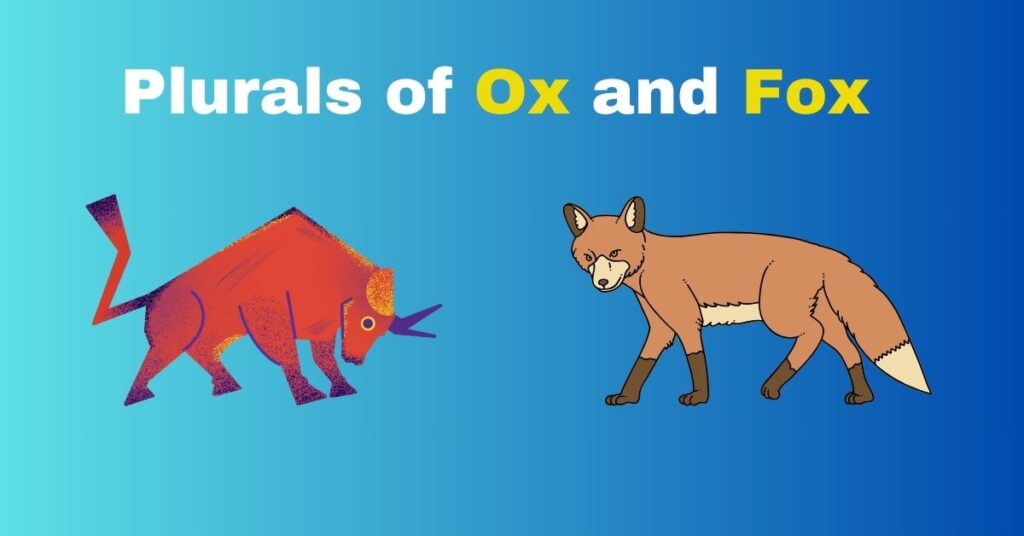What Are the Plurals of Ox and Fox Why Oxen and Foxes? The English language is full of quirks, especially when it comes to pluralizing nouns. Many words simply add an “s” or “es,” but some—like “ox” and “fox”—don’t follow the usual rules. You’ve probably noticed that the plural of “ox” is “oxen” and that of “fox” is “foxes.” But why? Is there a logical reason behind it? In this article, we’ll explore the fascinating history and grammar of these two words, shedding light on why they have different plural forms.
Definition
Oxen: The plural of “ox,” a domesticated cattle used for agriculture or work.
Foxes: The plural of “fox,” a small, carnivorous mammal with sharp features and a bushy tail.
“Foxes” is the standard pluralization, whereas “oxen” is still an example of an older, irregular form.
Meaning & Explanation
Why “Oxen” and Not “Oxes”?
The term “oxen” is derived from Old English, in which most words made the plural with the addition of the suffix “-en”. Examples include “ox” and “child” (plural: “children”) as the products of this very ancient pattern.
In Old English, “ox” was spelled “ox,” and the plural form was “oxan,” which eventually evolved into “oxen.” This aberrant plural form has endured across the centuries, even as the rest of the language succumbed to more standardized forms.
Why “Foxes”?
Conversely, “foxes” also obeys the contemporary English rule for words in “-x.” When a noun is in “-x,” the plural form is obtained by adding “es” (e.g., “box” → “boxes”).
The normal pluralization pattern for “fox” follows the way most nouns pluralize in English nowadays, and it is easy and predictable.
Insights from Linguists
Linguists, like David Crystal (one of the world’s leading experts on English grammar), observe that most English irregular forms have their origins in the Germanic languages that contributed to Old English. These forms, like “oxen,” remain as linguistic relics, even as English grammar has modernized.
Examples & Usage
Examples of “Oxen”:
“The farmers employed an oxen team to plough the fields.”
“In medieval times, oxen were used for transport and heavy work.”
“The oxen pushed the cart along the muddy roads, strong and steady.”
These instances depict the usage of “oxen” both historically and in contemporary usage, particularly in agriculture.
Examples of “Foxes”:
“A fox family resides close to the forest.”
“The foxes ran across the yard in search of food.”
“Winter, the foxes thicken their coats to keep warm.”
Both in the wild or in cities, “foxes” is an everyday name for the species with its plural form being used frequently both in nature-related matters and colloquial speech.
Types & Categories of Oxen and Foxes
Oxen:
| Type | Description |
| Working Oxen | Used for agricultural labor, like plowing and pulling carts. |
| Domesticated Oxen | Raised for meat or milk, often in farming environments. |
| Bulls | Male cattle, sometimes confused with oxen, though not castrated. |
Foxes:
| Type | Description |
| Red Foxes | The most common species, characterized by reddish fur and a bushy tail. |
| Arctic Foxes | White-furred foxes adapted to cold climates, found in the Arctic. |
| Fennec Foxes | Small desert foxes with large ears, native to the Sahara. |
| Gray Foxes | Renowned for climbing trees, they possess gray coats. |
These divisions present a further analysis of oxen and foxes’ diversity and reflect functional purposes in agriculture as well as intriguing species diversity in nature.
Related Words & Synonyms
- Oxen:
- Bovine
- Cattle
- Bullocks (young oxen)
- Steers (castrated male cattle)
- Foxes:
- Vulpine (related to foxes)
- Reynard (literary term for a fox)
- Canids (family of foxes, wolves, and dogs)
- Cunning (common descriptor in literature)
These related terms help expand your understanding of the two animals, showing how they’ve appeared in both everyday language and cultural references.
FAQ Section
1. Why is “oxen” rather than “oxes” used?
Linguistic History: The plural “oxen” is a leftover from Old English, when numerous plural forms were formed using the “-en” suffix. It is one of the few remaining examples of this pattern in contemporary English.
2. Can I say “foxes” as “foxes” instead of “foxes”?
- No Alternative: “Foxes” is the only accepted plural for “fox.” There is no alternative form like “foxes” in standard English.
3. Are there other irregular plurals like “oxen”?
Yes: Such examples as “children” (from “child”) and “kine” (from “cow”) also indicate older English patterns of pluralization, although they are not so frequent now.
4. Why are there irregular plurals in some English words?
Language Change: English has developed from the combination of Germanic and other languages. This has resulted in the retention of some older, irregular forms with newer words taking on simpler plural rules.
Conclusion
What Are the Plurals of Ox and Fox Why Oxen and Foxes? The plurals of “fox” and “ox” are an interesting peek at the development of the English language. Though “oxen” is an Old English leftover, “foxes” obeys the rule of modern pluralization that we find in the majority of modern vocabulary. To know these exceptions is to know and love the complexity and elegance of English grammar, which adapts yet clings to rich historical roots.






